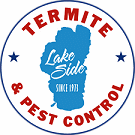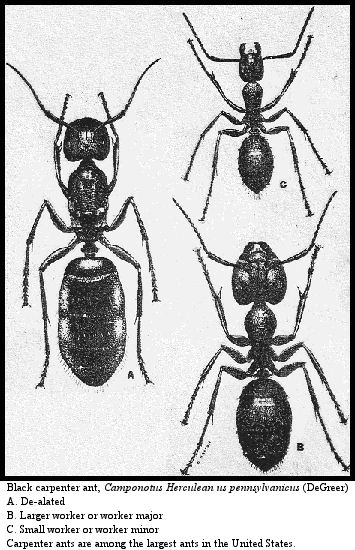

~ Carpenter Ants ~

Carpenter ants are distributed widely throughout the United States, causing severe structural damage to many homes!
[Carpenter ants Camponotus spp. WORKER SUBFAMILY CHARACTERISTICS: FORMICINAE. Abdominal pedicel composed of one segment. Sting absent. Tip of abdomen with a circular fringe of hair.]
Please Note: The information presented is taken DIRECTLY from the 7th edition of;
Mallis - Handbook of Pest Control © 1990
We wish to give full credit to Arnold Mallis for his lifelong contribution to the Pest Control industry.
WORKER SPECIFIC CHARACTERISTICS.
Profile of thorax is evenly rounded and the workers are polymorphic.
These long-legged; swiftly moving creatures are among our largest ants, which often invade homes foraging for food or for nest building. The workers are highly polymorphic, that is they vary greatly in size ranging from 1/4 inch to more than 3/4 inch. The queens may be more than1/2 inch long. The black carpenter ant, Camponotus pennsylvanicus (DeGeer), is the most common carpenter ant in the eastern states. It is a dull black color with an abdomen covered with long yellowish hairs pressed against the body surface.
Foraging workers may be from ¼ to 1/2 inch/ 6 to 12 mm or more in length. Other common eastern species include the red carpenter ant, C. ferrugineus (Fab.), and the Florida carpenter ant, C. abdominalis. Although found in much of the eastern United States, C. rasilis Wheeler, is probably one of the most common species encountered in the Gulf Coast states. Its head, thorax and petiole are reddish and the gaster is black. Worker size varies from 4 to 9 mm long. A species found throughout most of the United States is C. nearcticus Emery, Which is smaller with the workers being 4.5 to 7.5 mm long.
In the West there are several species, but C. modoc Mayer is the most common (Story, 1988). The body of this ant is black, but the legs are deep red and the abdomen has long yellow hairs. Foraging workers may be from 1/5 to 1/2 inch/5 to 12 mm in length. Other species of carpenter ants in the western states include: black, C. laevigatus (F. Smith); brownish 'with black, C. hyatti Henry, C. clarithorax Emery, or red and black, C. vicinus Mayr.
BIOLOGY. Carpenter ants, because of their large size and biting ability, attract more than a passing glance from even the neophyte nature lover. It is a common experience of hikers, who seek the comfort of a woodland log, to find themselves suddenly beset by large numbers of these biting ants. Carpenter ants are distributed widely throughout the United States and range-from sea level to well above 9,000-feet in the western-mountain ranges. They very often are pests in lawns as well as homes. Since theirs is the habit of dwelling in and excavating wood, they were given the common name of “carpenter ant."
The colony is ordinarily initiated by one queen, who begins the nest beneath a rock or in the soil, or in an insect-bored tunnel in a tree, etc. The queen lays only a few eggs and these hatch into very small workers. The minims or small workers then go forth to forage. The small workers then feed the young and the queen, whose sole interest in life is the production of eggs. If the environment is propitious, the colony thrives. The pupae are enclosed in cocoons, which are referred to by most individuals as "ant eggs." When the nesting site is in wood, it often resembles an ornate carving due to the multiplicity of the galleries. These galleries are so smooth, they appear to have been sandpapered. The carpenter ants ordinarily excavate that portion of the wood softened by decay or by the attacks of other- insects. However, Fowler (1986) stated that carpenter ants are more often found in sound wood than rotten wood.
Pricer (1908) made a detailed study of the life history of the black carpenter ant in Illinois at a temperature of 70° to 90° F/21 to 32°C. The female laid 22 eggs in 15 days. The egg stage took 24 days, larval stage 21 days and pupal stage 21 days (66 days from egg to adult). Under natural conditions, the larval stage may be of much longer duration during the winter. The winged sexual forms were observed to emerge about the first of July. Large colonies may be characterized by winged males and females during the winter. The colony does not produce the winged forms until it is more than two years old. These winged sexuals, which may be produced during one summer, over winter in the parental nest and emerge for their marriage flight from May to July. One colony had as many as 3,212 worker ants.
Blake (1940) notes there may be more than one queen in a colony and the largest workers may lay eggs, which only produce male ants. After mating, the queen makes or finds a smaller chamber in which she remains, sealed up, until her first brood of workers is adult. This requires at least two months and sometimes as long as 10 months." Most of the work of the carpenter ant is done by smaller workers.
Anon. (1959) reports these ants are able to withstand cold because they generate glycerol in their bodies whenever the temperature falls below a certain point. This is nature's way of manufacturing' 'antifreeze." The addition of tri-glycerides occurs with many other insects including several stored product insects (Granovsky, 1978).

Ants of the genus Camponotus apparently have better eyesight than ants of most other genera. Consequently, they are successful hunters. The carpenter ants also attend aphids and other honeydew-secreting insects.
CARPENTER ANTS IN THE HOME. Furniss (1944), who studied the control of carpenter ants in Oregon, discusses their infestations in homes as follows: "Where an infestation is long standing and the colony is a large one consisting of several thousand ants, structural damage is frequently extensive enough to require major repairs. If the infestation is noted at an early stage, however, all that may be necessary is to get rid of the ants. But this can be a costly and exasperating experience." Granovsky has found that in talking with pest control personnel coast to coast during 1988 that carpenter ants were the most frequently encountered and problematic ants. Many firms reported “callbacks" for additional service and many indicate no other insect pest is as hard to control. Dukes and Robinson (1982) reported that for PCO's in four eastern states, only 20 percent did more than 40 jobs for carpenter ants each year and 50 percent required return visits.
Furniss (1944) further indicated: "Carpenter ant colonies become established in new situations either through invasion by a fertile queen and development of her' progeny, or through immigration of all or part of an existing colony. The latter seems to be the more common way in which houses become infested through satellite colonies. Evidence gathered over a period of several years shows that houses near wooded areas, 'stump' land or brush-covered vacant lots are most likely to become infested, although it is by no means uncommon for carpenter ants to invade dwellings in thickly populated districts of a city. Ants from any neighboring colony may move into a house, especially when seriously disturbed, as often happens in the clearing of building sites. Cases are on record where disturbed carpenter ants become established in new houses before the homeowners moved in. Usually they take the course of least resistance and enter any available openings about the foundations, but occasionally they exhibit considerable ingenuity in gaining access to a house, and have even been known to enter along telephone and electric wire. (Note: They may enter the home by crawling on branches that contact the roof and other parts ot the house.) Often the point, or points, of entry are considerable distance from the place where the brood galleries are excavated:' Carpenter ants have been observed foraging 300 feet/91 m from their nest. Scent trails are laid between food sources and the nest.
Furniss (1944) stated: "All kinds of houses, from the oldest to the newest and from the most poorly constructed to the best, may become infested. In general, the houses most subject to attack are frame buildings without basements or with only part basements, those with very low foundations, those with open rambling porches, and those of loose construction, such as rustic cabins. The ants show some preference for moist rotting timbers about the foundations, but readily mine sound dry wood any place in a house. Among the commonly mined portions are porch pillars and supporting timbers, sills, girders, joists, studs and casings of houses, garages and other buildings; Dukes and Robinson (1982) reported there is a tendency for older homes to become infested, yet 79 percent of the PCOs reported a 25 percent or less association with actual structural damage.
According to Furniss (1944), "When a house becomes thoroughly infested there is little likelihood that the fact will be long un-noted by the human occupants. The continued presence of numerous workers, whether they are attracted to food or are merely running around the rooms, is strong evidence that a colony is established in the house. On warm days early in the spring, many people first become aware of carpenter ants in their homes when swarms of large winged ants emerge from the walls and try to escape through the windows. The appearance of these winged forms is an almost certain sign of continued trouble, for the main part of the colony remains behind and continues to develop, unless controlled. A faint, rustling sound in walls, floors and woodwork is another common clue to the presence of carpenter ants. Often the workers make slit-like openings through the surface of infested wood and through these openings expel their borings, which accumulate beneath in characteristic piles of fibrous 'sawdust'. Such refuse piles can be found most frequently in basements, in dark closets, under porches and in similar out-of-the-way places. They are a sure sign that a colony is established…"
In the eastern United States, Dukes and Robinson (1982) found that in 1980 (Note: at time of updating this website it is 25 years later - 2005) control charges ranged from $100 to $3,000, with an average of $206 per job. The highest charge by one PCO was just under $10,000 but 70 percent of the pest control operators charged more than $100 and 12 percent indicated costs to the customer on average of more than $300 per job (1980 prices). A solid review of control considerations is provided by Story (1988).
Carpenter ants represent a growing profit center for pest control operators interested in tapping into this lucrative market. However, it takes specialized expertise, along with a commitment to quality workmanship and proper customer relations to do the job right.
Click Here for Our Carpenter Ant Treatment Procedures
Lakeside Pest Control has been serving the Tahoe Basin since 1973.
We are your Carpenter Ant experts !
Call us Toll Free @ 1-800-528-4373
We look forward to being of service to you !



